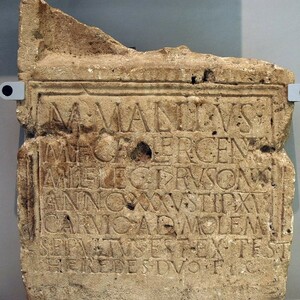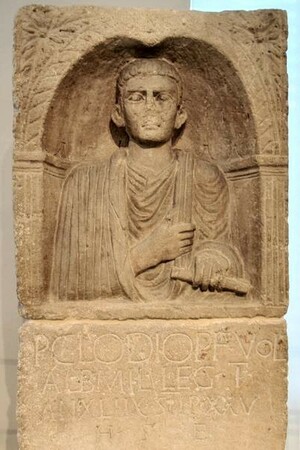Roman Legion - Legio I Germanica
Legio I Germanica was created by Gaius Julius Caesar in 48 BC to fight his opponent, Gnaeus Pompey the Great in the civil war for control of Rome that broke out between them.
Date of creation: 48 BC. The legion existed until its disbandment in 70 AD.
Emblem: Unknown, but it is suggested that since the legion was created by Gaius Julius Caesar, the emblem might have been a bull or a calf.
Nickname: Germanica, indicating its participation in the Germanic Wars of the Roman Republic and Roman Empire.

Battle Path
- It is believed that Legio I Germanica was created by Caesar in 48 BC to fight his opponent, Gnaeus Pompeius Magnus, in the civil war for control of Rome that broke out between them.
- The legion actively participated in the civil war between Caesar and Pompey, as well as in the subsequent struggle for power between Octavian Augustus and Caesar's assassins, and later with Mark Antony. The legion fought on the side of Octavian.
- The legion participated in the Battle of Dyrrachium in 48 BC, and then from 41 to 36 BC, it fought against Sextus Pompeius. Later, it took part in the Battle of Actium in 31 BC.
- After the Battle of Actium, the legion was transferred to Hispania Tarraconensis (Tarraconian Spain) in 30 BC, where it took part in Augustus' campaigns against the Cantabrians, which lasted from 25 to 13 BC. Tarraconian Spain was one of the three Roman provinces on the Iberian Peninsula, comprising Roman Spain, existing from the end of the 1st century BC to the end of the 3rd century AD. The legion fought alongside Legio III Augusta, Legio IIII Macedonica, Legio V Alaudae, Legio VI Victrix, Legio IX Hispana, Legio X Gemina and Legio XX Valeria Victrix legions. Together with soldiers from Legio III Augusta, they founded the city Colonia Iulia Gemella Acci in Tarraconian Spain.
- After the Cantabrian War, veterans of Legio I Germanica were settled in the Italian city of Luceria (modern Lucera, Italy), the Spanish city of Barcino (modern Barcelona, Spain), and the Mauritanian city of Cartenna (modern Ténès, Algeria).
- Around 16 BC, the legion was transferred to the Germanic frontier, where it participated in Tiberius' military campaign against the Vindelici – a Celtic kingdom in the upper Danube region. It is likely that the legion distinguished itself in the Battle of Lake Constance during this campaign, earning the honorable nickname “Germanica.” There is also a theory that a vexillation of the legion participated in the establishment of a military camp in Mogontiacum (modern Mainz, Germany) in 16 BC.
- From 12-9 BC, the Legio I Germanica participated in the military campaigns of Drusus the Elder, the stepson of Emperor Octavian Augustus, in Germany, as indicated by an inscription found near Nijmegen (modern Nijmegen, Netherlands).
- In the summer of 6 AD, Tiberius included the legionaries of Legio I Germanica in a large Roman army of 13 legions for a military operation against the Marcomanni king Maroboduus. However, the campaign was called off due to uprisings in Pannonia and Illyria, known as the Great Illyrian Revolt (6-9 AD).
- After the defeat of Legio XVII, Legio XVIII, and Legio XIX in the Battle of the Teutoburg Forest in 9 AD, Legio I Germanica, along with several other legions, was sent to the Rhine frontier to occupy the fortresses of Lower Germany and prevent possible invasions by Germanic tribes into Roman territory – Gaul. At that time, Legio I Germanica was commanded by Legate Lucius Nonius Asprenas.
- From 9 to 16 AD, Legio I Germanica was stationed in the city of the Ubian Altar (modern Cologne, Germany), the capital of Lower Germany. In 14 AD, after the death of Emperor Augustus, Legio I Germanica participated in the mutiny of the Germanic legions. The rebellion was suppressed, and the legion's veterans were settled in Raetia. Following this, in 15 AD, vexillations of the legion took part in Roman military campaigns against two ancient Germanic tribes – the Chatti and Bructeri. Raetia was the westernmost of the Danubian provinces of the Roman Empire.
- In 16 AD, the entire legion was involved in Germanicus' new campaign in Germany, participating in the Battle of Idistaviso, which the Romans won.
- In 21 AD, vexillations from four Germanic legions, including Legio I Germanica, under the command of Tribune Torquatus Novellius Atticus, participated in suppressing the uprising of the Gallic tribes Andecavi and Turoni, who revolted against high Roman taxes under the leadership of nobles named Julius Sacrovir and Julius Florus.
- Little is known about the military path and activities of the legion from 21 to 67 AD. Vexillations of the legion, along with those from other Germanic legions, were stationed near Colonia Agrippina (modern Cologne, Germany) in the 30s AD.
- Between 28 and 35 AD, the entire legion was transferred to Bonn (modern Bonn, Germany).
- In 67 AD, Governor of Lugdunensis Gaul, Gaius Julius Vindex, and the supporting Governor of Tarraconensis Spain, Servius Sulpicius Galba, raised a rebellion against Emperor Nero (ruled 54-68 AD).
- The forces of Lower Germany, including Legio I Germanica, defeated Vindex, but Galba's forces were more fortunate. Galba, having defeated several armies, advanced on Rome, leading Emperor Nero to commit suicide in 68 AD, and Servius Sulpicius Galba became the new emperor.
- The new emperor did not significantly reward the forces of Lower Germany, including Legio I Germanica. In response, Legio I Germanica, followed by all other Lower Germanic legions, proclaimed their governor of Lower Germany, Aulus Vitellius, as their emperor.
- The forces of Legio I Germanica were divided into two parts: one part, led by the legion's legate Fabius Valens, marched to Italy to fight for Vitellius, who eventually won and became emperor but was already preparing for war with a new contender for power, General of the Eastern Imperial Forces, Vespasian. The other part of the legion, under the command of Herennius Gallus, remained in Lower Germany and participated in suppressing the Batavian rebellion (an ancient Germanic tribe allied with Rome) in 69 AD. The Batavians, offended by Emperor Galba's dismissal of several of their tribe members from his bodyguard, revolted. By March 70 AD, the Batavians managed to defeat all remaining forces of the Lower Germanic army, including Legio I Germanica. Some soldiers of Legio I Germanica joined the forces of Civilis (leader of the Batavian revolt), while others joined the army of the new governor of Lower Germany, Quintus Petillius Cerialis, sent by the victorious Vitellius, the new emperor Vespasian, to suppress the Batavian revolt. In the final phase of suppressing the Batavian revolt, the legionaries of Legio I Germanica performed very poorly, and as a result, by order of Emperor Vespasian, Legio I Germanica was disbanded in 70 AD, with its remaining soldiers being incorporated into Legio VII Gemina.
Related topics
List of Roman Legions, Legion, Legionnaire, Gaius Julius Caesar, Gnaeus Pompey the Great, Octavian Augustus, Legio III Augusta, Legio IIII Macedonica, Legio V Alaudae, Legio VI Victrix, Legio IX Hispana, Legio X Gemina, Legio XX Valeria Victrix
Literature
1. Emil Ritterling. Paulys Realencyclopädie der classischen Altertumswissenschaft. Legio (I). Band XII,2. — Stuttgart, 1925. — 1376—1380 p.
2. Lawrence Keppie. The making of the Roman Army. From Republic to Empire. — Norman OK: University of Oklahoma Press, 1998.
3. Lesley Adkins. Handbook to Life in Ancient Rome. — Sonlight Christian, 2004.
4. Jerome H. Farnum. The Positioning of the Roman Imperial Legions. — Oxford: BAR International Series 1458, 2005.
5. Kanya River. A brief history of the various legions. Legio. 2001.
6. Jona Lendering. Legio I Germanica (English). Livius.org. 2002.
7. Legio I Germanica. imperiumromanum.com.




